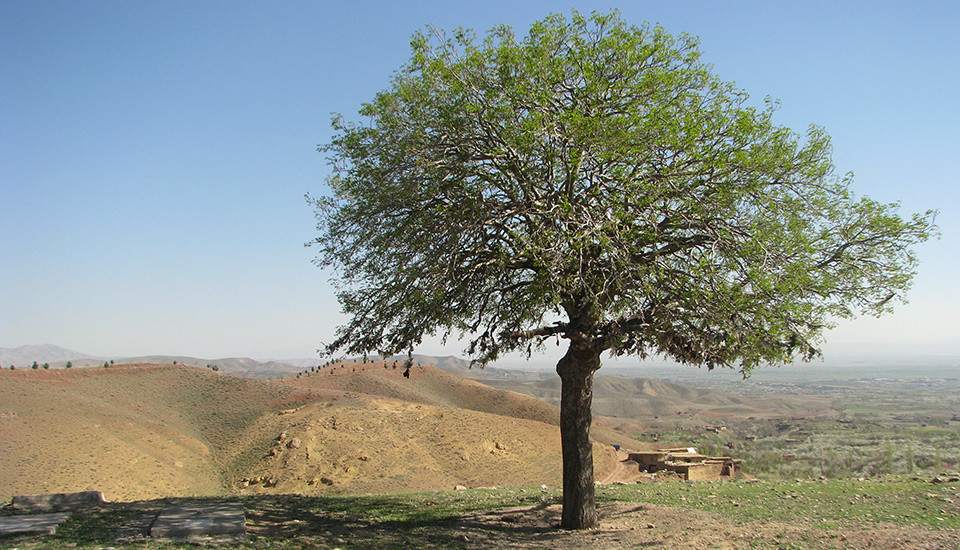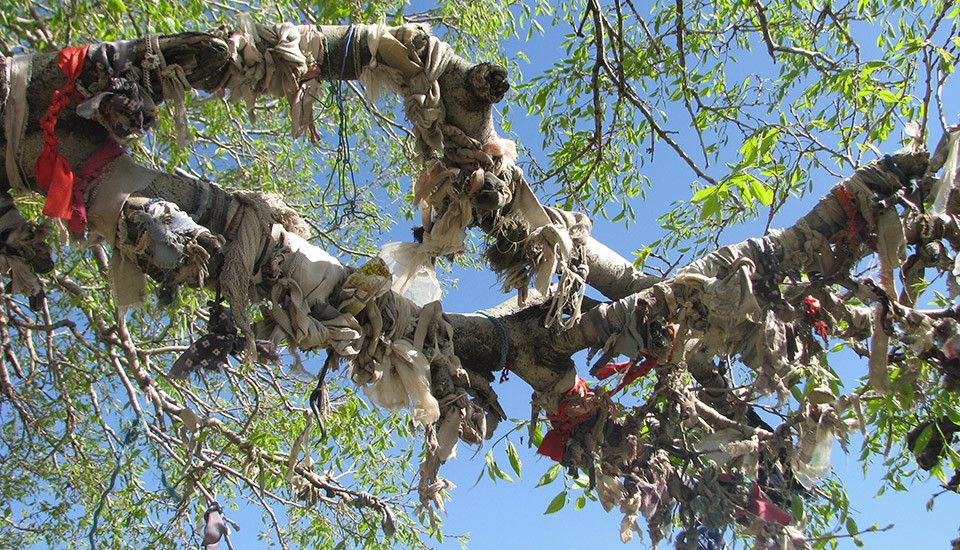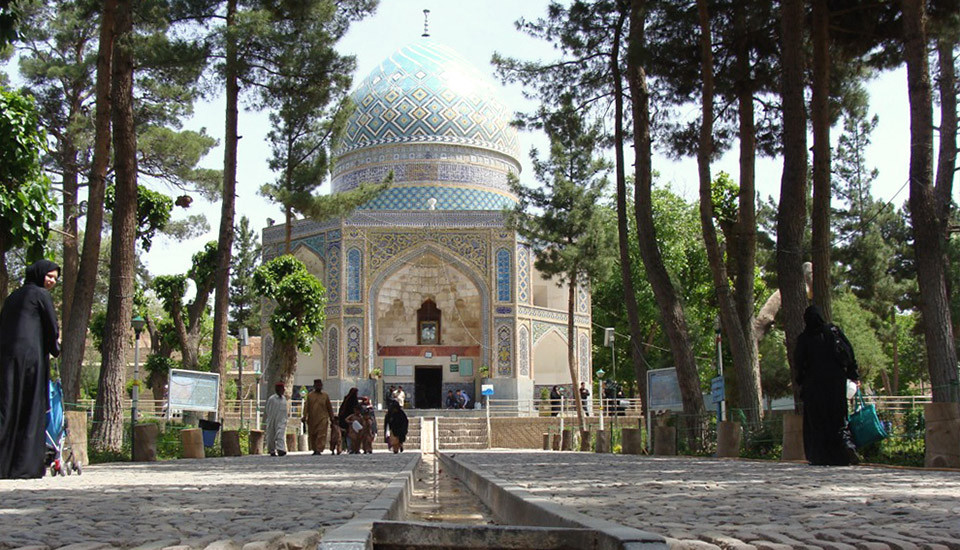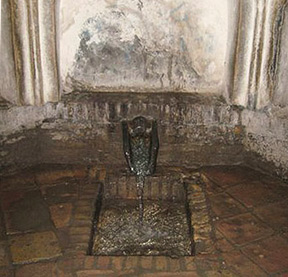Neyshabur to miasteczko w północno-wschodnim Iranie. Duża część z nich znajduje się na rozległej równinie otoczonej wzgórzami i górami. Istnieją różne święte obiekty przyrodnicze w gminie, od świętych drzewach i sprężyn do świętego świętych i święte głaz ogrody. Powierzchnia mieści kilka endemicznych gatunków roślin i zwierząt. It also contains protected areas and ecotourist destinations such as waterfalls, Sprężyny, rzek i wzrok cechy geograficzne, takie jak szczyty górskie. The climate is semi arid to dry with an average annual rainfall of 300 mm.
In spite of the fact that these sites are protected by local communities, their future is threatened by urbanisation, population growth, infrastructure development and tourism.
Chroniony
Kuratorzy
Miejscowi ludzie szanować naturalne cechy, jak są one zakorzenione w ich religijności. Qadamgah w Neyshabur na przykład, jest perski ogród, gdzie natura została nasycona wartościami duchowymi. Zawiera dwór, drzewa, Baseny i strumienie. Jedna ze ścian dworu zawiera czarnego kamienia, w którym dwa ślady zostały wycięte. Ludzie wierzą, te odciski należą do 8 Imam szyitów, mężczyzna przywódca duchowy uważany potomkiem Muhammed, bosko powołany do kierowania ludźmi. Qadamgah słowo oznacza ślad i odnosi się do tej narracji.
Historia Qadamgah jako święta strona sięga okresu przedislamskiego. Chociaż jego pierwotny cel jest nieznany, Jest historycznie powiązany z Kasrą Sassanid Prince Shahpour, a także Imam Ali i Imam Reza. Słowo idzie 921 Ad Imam Reza zatrzymał się w ogrodzie w drodze z Medyny do Marv. W chwili, gdy chciał wykonać swoje ablucje, Wiosna wychodziła z ziemi. Od tego czasu wiosna jest uznana za święte, a ludzie wierzą, że ta woda ma właściwości lecznicze.
Niektóre drzewa samolotowe (Plantan sp.) są aktywnie zachowane od wieków. Samolotowe drzewa w Iranie były uważane za święte od dawna ze względu na cień, który oferuje, ich wielkość i zielony wygląd. W całym Iranie niektóre drzewa samolotowe są utrzymywane przy życiu od wieków. Legendy i przekonania o niektórych okazach spowodowały, że ludzie trzymali się z dala od nich. Długie żyjące drzewo samolotowe w wiosce Neyshabur, na przykład, jest zachowany przez miejscową ludność, ponieważ wierzą, że mężczyzna stracił kiedyś rodzinę z powodu złamania swoich gałęzi.
Miejscowi nadal oszczędzają mniej znane święte miejsca, które nie mają ochrony prawnej. Wartości takich miejsc uczy się młodych pokoleń i ceremonii religijnych i praktyk odbywa wspólnotowo, tak jak były one przez wieki. W ten sposób, następne pokolenie uczy się je chronić.
Chociaż nie jest formalna strategia zarządzania, Ludzie mają tendencję do ochrony swoich witryn. Niektóre wdrażają krótkoterminowe środki na poziomie lokalnym. Na przykład wśród szerokiej gamy planów, które są przeprowadzane, Opracowano tam park wokół drzewa życzeń i usług turystycznych.
Akcja
Miejscowi i instytucje religijne kontynuują swoje odwieczne praktyki. Lokalne biura Dziedzictwo kulturowe, Rękodzieło i turystyka Zarejestruj długowieczne drzewa jako krajowe pomniki naturalne. Krajowe zabytki naturalne są stosunkowo małe, ciekawy, unikalny, wyjątkowy, niekonwencjonalne i niezastąpione zjawiska zbiorów roślin i zwierząt o nauce, historyczne lub naturalne znaczenie. Środki ochronne na tych obszarach gwarantują ich zrównoważone niekomercyjne wykorzystanie.
Istnieje również krajowy plan zapasów i ochrony długo żywych drzew pod nadzorem lasy, Organizacja zarządzania zasięgiem i wodą Iranu. Ostatnie badania Maryam Kabiri zwracają uwagę na znaczenie wartości duchowych, które te i inne święte miejsca mają w odniesieniu do ochrony natury.
Polityka i prawo
Prawodawstwo Iran nie ma wzmianki o świętych naturalnych dotąd. Niektóre święte obiekty przyrodnicze zostały oficjalnie zachowane, ponieważ znajdują się na obszarach chronionych lub w krajowych pomnik. Inne zostały specjalnie zarejestrowany jako krajowych pomników przyrody. Dziedzictwo kulturowe i dział organu ochrony środowiska mają do powiedzenia w sprawie ochrony narodowych zabytków przyrody. Proponują one głównie rzadkich flory i fauny lub niezwykłych formacji lądowych, pejzaże czy nawet starych drzew. Są one następnie objętych ochroną w ramach wyznaczenia odpowiedniego obwodu.
Koalicja
Niektóre święte miejsca w okolicy są pod nadzorem Endowments i organizacje charytatywne (Odpowiedzialny za wyposażenie i święte miejsca, takie jak meczety i świątynie) oraz rada powiernicza lokalnej ludności. The Dziedzictwo kulturowe, Handicrafts i organizacja turystyczna jest odpowiedzialny za rejestrację i zarządzanie zabytkami historycznymi i krajowymi zabytkami naturalnymi.
Stepping, na przykład, został zarejestrowany w ten sposób, Ale jest również pod nadzorem dania i organizacji charytatywnej Iranu i lokalnej rady powierniczej. Jak w przypadku Qadamgah, Kiedy strona ma zarówno wartości kulturowe, jak i duchowe, organizacje te współpracują w zakresie ochrony i zarządzania witryną.
Narzędzia ochrony
Utworzono kryteria ochrony, a kryteria te doprowadziły do map obszarów w miasteczku Neyshabur, które wymagają priorytetu ochrony. Niektóre zalecenia zostały dodatkowo sformułowane w tej pracy, co może pomóc w początkowych krokach planowania programu politycznego i rozwijania kryteriów i wskaźników krajowego pomnika naturalnego, tak że uwzględniają wartości duchowe.
Wyniki
Święte miejsca naturalne w ramach różnorodności kulturowej bio -kulturowej są przez wieki przez wieki przez lokalne przekonania i wartości. Obecnie strony te są zagrożone z różnych powodów. Jeśli mają przetrwać, Obecne środki muszą być obsługiwane przez ochronę prawną. W tym celu, przyjęcie zintegrowanego podejścia opartego na wspólnych kryteriach i polityk w dziedzinie przyrody i kultury mogą odgrywać kluczową rolę w zakresie ochrony świętych naturalnych. Kabiri Hendi (2011) zidentyfikować takie kryteria dla ochrony świętych naturalnych terenów w gminie Neyshabur.
- Bahar, M. (1995) Od mitu do historii. Publikacja Cheshmeh, Teheran, Iran.
- Daneshdoost, J. (1992) Ogród perski. ASAR Journal, Vol.12: 48-52.
- Kabiri Hendi, M. (2011) Ocena gruntów ochrony miejsc naturalnych o wartości duchowych, Studium przypadku Neyshabur Township. Praca magisterska na Teheran University, Droga, Iran.
- Taheri, A. (2009) Przewodnik turystyki Neyshabur. Abwshahr, Mashhad, Iran.
- Opierać, B (2005) Kompleks lasów finansowych, Klub, Issue7:86-93.







